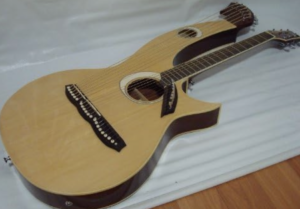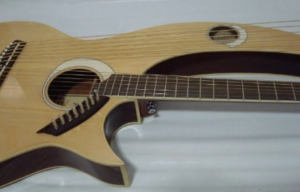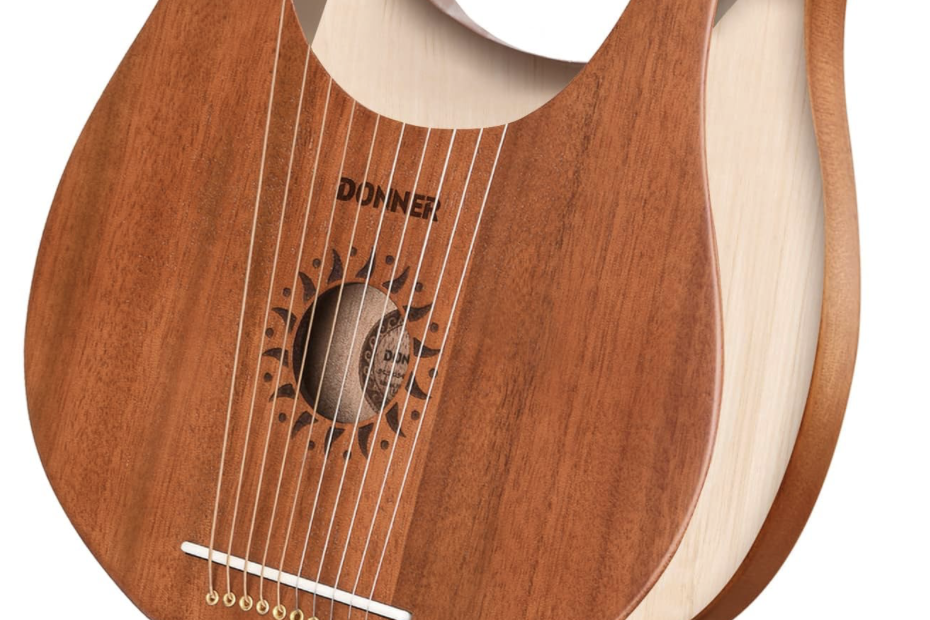In the realm of musical instruments, the harp guitar stands out as a fascinating and enchanting creation that captures the imagination of both musicians and audiences alike.
A harmonious marriage between the traditional guitar and the ethereal harp, the harp guitar combines the versatile capabilities of the six-string guitar with the mesmerizing sounds of the harp, resulting in a unique and captivating musical experience.
What is a Harp Guitar?
 The harp guitar, as the name suggests, is a hybrid instrument that features characteristics of both the guitar and the harp. While the basic structure resembles that of a conventional guitar, the instrument distinguishes itself by having one or more additional strings that run parallel to the regular guitar strings. These additional strings are typically found above the fretboard, and they are longer than the main strings, extending beyond the soundboard.
The harp guitar, as the name suggests, is a hybrid instrument that features characteristics of both the guitar and the harp. While the basic structure resembles that of a conventional guitar, the instrument distinguishes itself by having one or more additional strings that run parallel to the regular guitar strings. These additional strings are typically found above the fretboard, and they are longer than the main strings, extending beyond the soundboard.
History and Origins
The origin of the harp guitar can be traced back to the early 19th century, where its early development and experimentation began. However, the exact origins of the instrument are not entirely clear, and there are several theories regarding its creation.
One of the earliest mentions of an instrument with this resemblance dates back to the early 19th century in Europe. It is believed that French luthier René Lacôte created a multi-stringed guitar-like instrument that featured additional open strings running parallel to the regular guitar strings. This design was intended to provide a harp-like sound and expanded tonal possibilities. However, the instrument didn’t gain widespread popularity at the time.
Around the same period, another French luthier named Naderman is also credited with developing a similar instrument called the “Naderman harp-guitar.” This instrument featured multiple necks, with the main neck housing the regular guitar strings, and the additional necks holding the harp-like strings. The Naderman harp-guitar was primarily used in classical music performances.
Also Read:
Guitar Headstock: An Iconic Musical Signature
7 Best Clip On Guitar Tuner Options
Guitar Paint: Enhancing and Protecting Your Instrument
Selecting the Best Guitar Pick
Mexican Guitar: The Enchanting Sound of the Guitarron
Guitar Anatomy: Understanding Guitar Components
The Name Harp Guitar
 The name “harp guitar” comes from the instrument’s unique combination of features that resemble both a guitar and a harp. The instrument incorporates the traditional structure of a guitar, including the familiar six strings and frets on the main neck, which is played by the guitarist’s fingers. However, what sets the it apart is the addition of multiple open strings, running parallel to the main strings, which are usually unfretted and resonate sympathetically when plucked.
The name “harp guitar” comes from the instrument’s unique combination of features that resemble both a guitar and a harp. The instrument incorporates the traditional structure of a guitar, including the familiar six strings and frets on the main neck, which is played by the guitarist’s fingers. However, what sets the it apart is the addition of multiple open strings, running parallel to the main strings, which are usually unfretted and resonate sympathetically when plucked.
These open strings on the harp guitar resemble the strings of a harp, and they can be plucked or strummed by the player’s hands, fingers, or even using dedicated picks. This design allows for a more expansive range of notes and tonal possibilities, akin to those found in a harp, in addition to the standard guitar range.
The instrument’s name, “harp guitar,” is derived from this characteristic combination of guitar and harp elements. The term was likely coined to describe the instrument’s unique sound and playing style, which combines the expressive capabilities of both instruments.
It’s important to note that the term can encompass various designs and configurations, as there are different types, including those with sub-bass strings, extended fingerboards, multiple necks, and other variations. Each of these designs adds to the instrument’s complexity and potential for sonic exploration.
The name “harp guitar” has been used for centuries to describe instruments with similar features, and it continues to be the recognized term for this distinctive and captivating hybrid musical instrument. Today, it remains a fascinating instrument cherished by musicians and enthusiasts for its evocative sound and the creative possibilities it offers.
Harp Guitar in the USA
 In the United States during the mid-19th century, a prominent harp guitar maker named Christian Frederick Martin is often associated with the instrument’s development. Martin, the founder of the Martin Guitar Company, built several of them that featured multiple sub-basses (additional strings) extending from the guitar’s headstock. These sub-basses were intended to provide a richer, deeper resonance and were tuned to lower pitches.
In the United States during the mid-19th century, a prominent harp guitar maker named Christian Frederick Martin is often associated with the instrument’s development. Martin, the founder of the Martin Guitar Company, built several of them that featured multiple sub-basses (additional strings) extending from the guitar’s headstock. These sub-basses were intended to provide a richer, deeper resonance and were tuned to lower pitches.
One of the earliest known harp guitars made by Martin is dated back to the 1830s. These early Martin guitars were primarily custom-made instruments and were played by accomplished musicians of the time.
The popularity saw its peak during the late 19th and early 20th centuries. Renowned guitarists like Wilhelm Tischner and Chris Knutsen showcased the instrument’s capabilities through virtuosic performances, bringing attention to its unique qualities.
While the instrument experienced a decline in popularity during the mid-20th century, it never completely disappeared. In recent decades, there has been a notable resurgence of interest in the instrument, with modern luthiers and musicians embracing its unique qualities and exploring new possibilities for its design and sound.
The Resurgence
Despite its decline, the harp guitar never completely disappeared. In recent decades, there has been a notable resurgence of interest in this fascinating instrument. A new generation of luthiers and musicians has embraced it, contributing to its revival and expanding its presence in contemporary music.
Design and Variations
Harp guitars come in various designs and configurations, each offering its own tonal palette and playing experience. Some harp guitars feature a single additional set of strings, while others boast multiple sets, providing a wide range of pitch possibilities. The additional strings are typically played as open strings, producing sustained drone-like notes that complement the melody played on the main strings.
The size and shape of the harp guitar can also vary. Some models resemble large-bodied acoustic guitars, while others have a more compact and sleek design. Some may include a hollow arm extending from the upper bout, housing the additional strings, and giving the instrument its harp-like appearance.
Playing Techniques and Musical Styles
Playing the harp guitar requires a unique set of techniques, as musicians must navigate both the traditional fretboard and the additional strings above it. This calls for a high level of skill and coordination, making it an instrument favored by skilled fingerstyle guitarists.
The versatility of this guitar allows it to be used in a wide range of musical genres and styles. From classical compositions to folk, blues, and contemporary acoustic arrangements, it can add depth and complexity to various musical expressions.
Innovation and Modern Harp Guitars
As the instrument continues to experience a resurgence, luthiers are pushing the boundaries of its design and construction. Modern versions may incorporate advanced acoustic engineering, innovative materials, and cutting-edge amplification systems, enhancing their playability and projection.
Conclusion
The harp guitar is a mesmerizing and enchanting instrument that bridges two worlds, creating a captivating and unique musical experience. Its rich history, coupled with its modern resurgence, showcases the enduring appeal of this extraordinary hybrid instrument. With the skills and artistry of contemporary musicians and luthiers, it is sure to continue leaving a lasting impression on both performers and audiences for generations to come.
